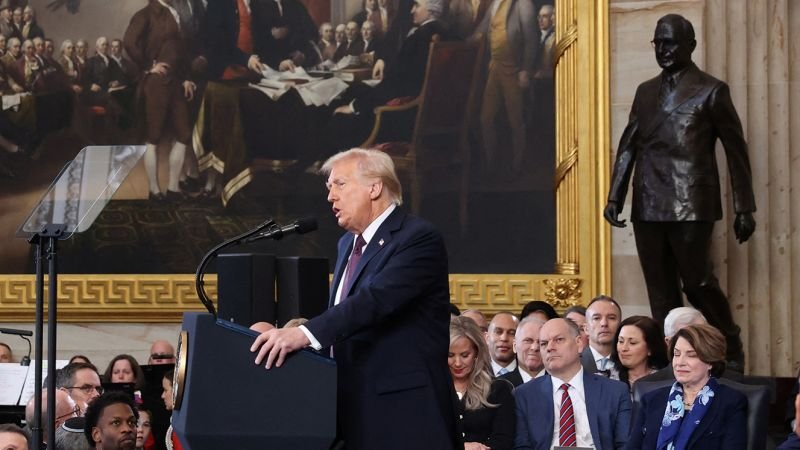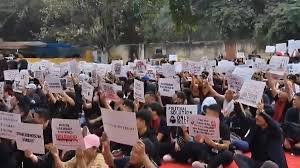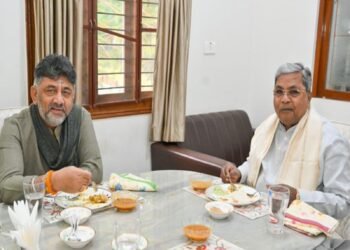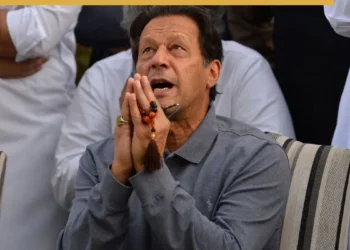President Trump’s second term kicks off with a flurry of high tariffs—25% on Canada and Mexico, 145% on China, and a looming 100% on BRICS nations including India—aimed at fortifying the US economy. However, this gamble risks global trade wars and undermines America’s soft power, creating confusion and fear among international partners.
By Annpurna Nautiyal
Donald Trump’s second advent in the White House as the 47th President of the United States of America has heightened anxiety not only within the US but throughout the world. His explicit declaration during his inauguration speech on January 20, 2025, that he was “saved by God to undo all the wrongs and make America great again” underscores his vision. He undoubtedly aims to make America Great Again and views the Democrats, particularly Joe Biden, unfavorably due to their perceived failures to end the wars in Ukraine and between Hamas and Israel.
President Trump’s Trade and Tariff Gamble
President Trump’s aggressive stance towards the policies and practices of the Democratic Party, and his efforts to swiftly end an era he believes took one-sided advantage of American “open-handedness” through imposing tariffs and taxes on trade, have made the whole world jittery. While he believes such measures will strengthen the American economy and provide much-needed reprieve to the American people, countries worldwide apprehend that initiating trade and tariff warfare will lead to widespread unrest and conflicts.
His declaration of imposing a 25 percent tariff on Canada and Mexico starting February 1, 2025, and threatening to impose 145 percent tariffs on China, indicates a very demanding approach. He has also warned of imposing a 100 percent tariff on BRICS nations, including India, for unfair trade practices, as well as high levels of taxes and sanctions on Russia. Recently, President Trump also announced that from June 4, 2025, America would increase tariffs on steel from 25 percent to 50 percent to secure the steel industry in the United States. This move is likely to increase tensions between the U.S. and its top steel partners: Canada, Brazil, and Mexico. The European Union has already reacted, announcing that Europe is prepared to retaliate against President Trump’s plan to double tariffs on imported steel and aluminum.
Interestingly, in view of retaliatory tariffs by various countries, he has paused tariffs with most countries, including China, for ninety days, suggesting that the initial tariffs were imposed hastily without fully assessing the repercussions. He has also delayed imposing 50 percent tariffs on all imports from the European Union. Instead of upholding a rule-based international order with the help of allies, US policies under Trump are arousing fear among states. This approach is proving to be a gamble, as the rapid declaration and subsequent pausing of tariffs are creating significant confusion.
READ: Honeymoon Horror: Meghalaya Police Confirm Murder of Missing Tourist
Threats to Immigrants, Institutions, Individuals, and US Visa Holders
The decision to impose strict visa rules for foreign students, curtail grants to renowned educational institutions in the US, withdraw from the World Health Organization and the Paris Accord on Climate Change, and refuse to cooperate in the production of clean and green energy, is increasing doubts about America’s relevance as a superpower. In this era of connection and connectivity for enhancing trade and security, such backward and untoward thinking has portrayed Trump as a visionless and callous leader with a limited understanding of trade wars, retaliations, and the changing world order.
The attack on universities by stopping their grants and funds for research, revoking student and researcher visas, and other repressive policies are hampering research on subjects that made America a technological superpower, such as clean energy and semiconductor manufacturing. This also adversely affects its “soft power” advantages. The conflict with a centuries-old prestigious educational institution like Harvard, by stopping its federal grant, denying visas to students, and not allowing it to admit foreign students, demonstrates his abrupt and uncompromising behavior. Stopping grants to public institutions that teach critical race theory, gender, diversity, and equity is particularly shocking.
The Donald Trump administration’s announcement that it will aggressively revoke visas for Chinese students, including those with connections to the Chinese Communist Party or studying in critical fields, has also alarmed Chinese students. US Secretary of State Marco Rubio also stated that the US will revise visa criteria to enhance scrutiny of all future applications from the People’s Republic of China and Hong Kong. The fear of visa denial and entry to the US due to social media posts by individuals is so high that students and others have been deleting their social media handles to ensure smooth entry. Indian students are also facing the impact of visa denials. While America has always been a harbinger of liberalized thought and expressions, Trump’s insistence on identifying only two genders (male and female) is seen as typical and puzzling. The shutting down of Diversity and Equity initiatives departments and targeting individuals further aggravates the looming scenario of gloom. Trump’s mindset and policies are seen as incomparable with other democracies, which, despite facing many problems, have evolved to openly accept transgender presence and identity. Michael Posner, in a recent New York Times article, has opined that America’s global influence, once advanced through advocacy of human rights and democracy, is now likely to be relegated to a weak, less principled, ethos-less, and transactional state due to Trump’s repressive policies and support for dictatorships and authoritarian regimes.
READ: Naga Students Overturn SP’s Vehicle as Home Secy Reviews Manipur Law & Order
Trump’s Untrustworthy and Myopic Policies
During the recent tension between India and Pakistan in the aftermath of the massacre of tourists in Pahalgam (Jammu and Kashmir region of India) and India’s launch of Operation Sindoor to avenge the deaths, Trump claimed credit for his astute diplomacy of using trade as a carrot to force both countries into a ceasefire within three days. He asserted that he used trade to convince both India and Pakistan that if they did not agree to peace, countries with trade interests would cease all trade with them. This contradicts the Indian Foreign Secretary’s statement that India and Pakistan agreed to stop firing and military action from land, air, and sea through direct talks between their military officials. Trump has repeatedly emphasized the trade and talks narrative despite India’s assertions and clear statements. Even during an event organized for Elon Musk’s departure from the Department of Government Efficiency, President Trump again repeated his claim that he used trade to broker peace and a ceasefire between India and Pakistan, thereby averting a nuclear disaster. Such a policy from Trump has not only favored Pakistan, helping it save face in a war against terrorism, but has also revived India’s memories of the Cold War era of deceit and deception.
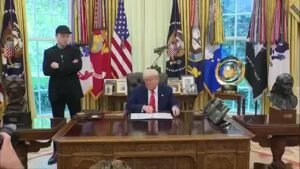
Despite Trump’s pro-Pakistan stance, India achieved its aim to avenge the death of Pahalgam tourists within three days by damaging various airbases and terrorist camps. However, US statements made it appear as though India could not achieve much and had bowed to US pressures to stop its airstrikes, presenting Pakistan as a close ally the US wanted to protect. It seems surprising that even after such a radical transformation of the global order, Trump appears inclined to revisit the Cold War era where suspicion, lack of trust, and vested interests guided the principles of a fruitful relationship. As Trump is a true trader, it is also being highlighted in the media that he sided with Pakistan due to his family’s investment and 60 percent shares in Pakistan’s cryptocurrency council.
READ: Ladakh reserves 85 pc jobs for locals, one-third seats for women
Trump’s assertion that he spoke to Apple CEO Tim Cook in Doha, Qatar, and told him not to construct factories in India unless they specifically served that market, exhibits his anti-India stance. He has also stated recently that Apple was free to build factories in India, but the company would face tariffs when selling its products in the United States. This is contrary to Tim Cook’s statement that India would play a significant role in making these phones for the US market. It also suggests that the US under Trump wants to play a different game with India and “my friend Modi.” The whimsical nature of President Trump’s policies is reflected in the fact that after claiming only he and Russian President Putin had the power to negotiate a deal, President Trump not only threatened to walk away from the Ukraine-Russia ceasefire negotiations but also hinted that he plans to leave Ukraine and other European countries to find their own solutions. His statement that the Russia-Ukraine war would not have started if he were president, and that the war belongs to Zelenskyy, Putin, and Biden, not “Trump,” clearly indicates this.
What Trump wants to prove with his “out-of-the-box” ideas is difficult to assume, as this is only the opening, and the final scenario is yet to evolve. As Kyle Chan recently wrote in The New York Times, there will be no doubt if Trump’s policies allow the commencement of a Chinese century sooner rather than later, by harnessing China’s vast economic and technological potential to surpass the United States. He believes this century may already have originated, and Trump’s second term will be a watershed moment where China might leave the United States behind. Even now, China leads global production in steel, aluminum, shipbuilding, batteries, solar power, electric vehicles, wind turbines, drones, 5G equipment, consumer electronics, pharmaceutical ingredients, and bullet trains. China is also leading in drug discoveries, especially for cancer, and industrial robotics surgeries. For semiconductors, China is building a self-reliant supply chain through Huawei. In recent statements, the US has named China as an imminent threat to Taiwan and the South China Sea and urged Asian countries to boost defense spending and work with the US to deter war with China. China, on the other hand, has accused the US of being the “biggest troublemaker” for regional peace. This clearly shows that it is not only a trade war but also a war of words resulting from US trade and tariff policies.
Trump’s obsession with tariffs is preventing him from accurately estimating the threat from China. He needs to realize that neither tariffs nor other trade pressure will force China to abandon its state-led tactics to dominate trade and industries. Trump has failed to recognize that, besides dividing the world, his tariffs are curtailing the power of US companies to dominate global markets. The contradictions of Trump’s policies are bizarre: on one hand, he wants to project an image of America becoming a strong and rich fort, but without any clear strategy beyond trade-related tariffs and taxes. On the other hand, by rolling out so many aggressive executive orders, he still wants to be addressed as a messiah of peace. He forgets that such expansionist policies project him as a person with dictatorial traits, possessing a desire for excessive centralization in a federal state, which could be fatal for a 21st-century America.
(The author is Former Vice Chancellor, HNB Garhwal University, Srinagar, Garhwal, Uttarakhand)


